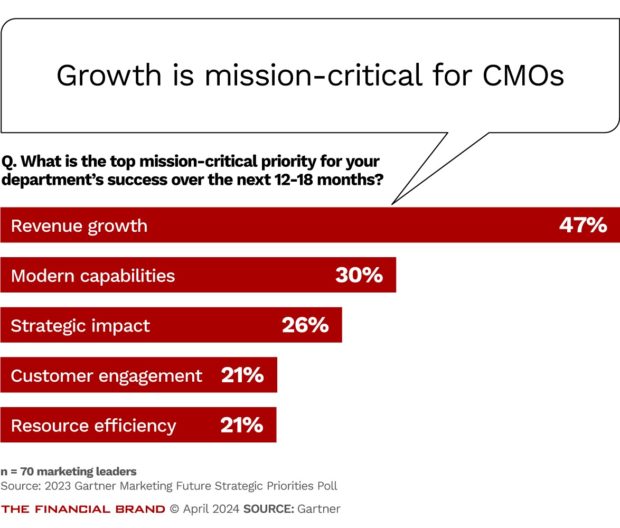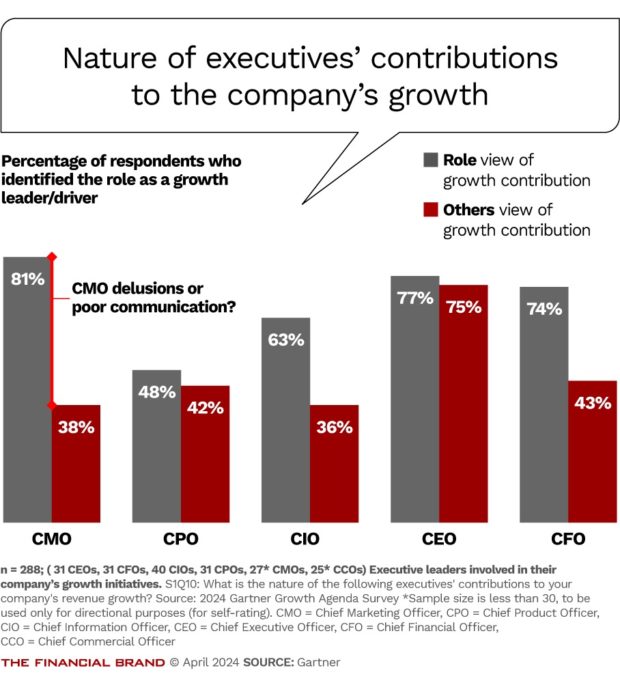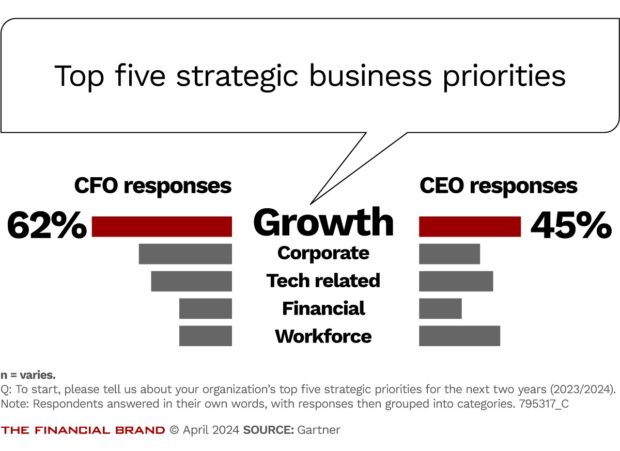CMOs are having a tough start to 2024. UPS, Walmart and Etsy became just a handful of global firms that retired top marketing positions in recent months in favor of spreading out the role across other departments. Megabanks like Bank of America and Wells Fargo were some of the first to sunset the position in 2021.
After the dismissals, the importance of the position itself has come into question — opening up a debate about the need for a CMO on the C-suite. But if the recent exits are proof of the end of the CMO role as we know it, what’s taking its place at some of the world’s top financial institutions?
The underlying problem is that marketing is not traditionally tied to the C-suite holy grail of growth. Old-school marketing often involves taglines, logos and packaging, and primarily excels at bringing attention to existing products. But in a world where analytics is king, marketers are having trouble demonstrating their direct value to the company – and are pivoting quickly.
“Marketing plays a vastly different role in business today than it did just 10 years ago,” says Tamar Kassoff, vice president of growth marketing at the payments fintech Plooto.
So-called “growth marketing” is becoming front-and-center in the battle for revenue growth. While traditional marketing looked at metrics like lead generation and brand loyalty, growth marketing is more closely tied to overall company strategies and data. The evolution of the CMO from overseeing ads placements to product innovation is a sign of a new era in executive thinking that’s blending sales, product and finance.
“Vanity metrics are a thing of the past,” Kassoff says. “Marketers have leaned into data to inform their strategies and have aggressive revenue targets.”

Unlocking Digital Acquisition: A Bank’s Journey to Become Digital-First
This webinar will offer a comprehensive roadmap for digital marketing success, from building foundational capabilities and structures and forging strategic partnerships, to assembling the right team.
Read More about Unlocking Digital Acquisition: A Bank’s Journey to Become Digital-First

Navigating the Role of AI in Financial Institutions
83% of FI leaders agree investing in AI is essential for 2024 but how you leverage AI is instrumental in success and meeting customer expectations.
Read More about Navigating the Role of AI in Financial Institutions
To be sure, the concept of growth marketing is in the early innings, so much so that experts don’t always agree on concrete definitions of some of the nomenclature. Detractors say traditional marketing should have always been focused on growth and certainly needed to contribute to the company’s bottom line.
But this renewed focus on growth seems to come with an additional benefit. It’s also helping CMOs and their teams become a critical part of the company’s strategy and tie their efforts directly to revenue.
“It’s not just about the look-and-feel or voice-and-tone. It’s not just about SEO and conversion rates either,” Kassoff says. “It’s about building an experience.”
Dig deeper: Why Banks Are Saying Goodbye To the CMO
Focus on the Problem, Not the Solution
When it comes to creating a growth marketing strategy, the first step is to take a hard look at the problem at hand, says Chris Ross, vice president of CMOs and marketing at the consulting firm Gartner. If the goal is 5% growth over the next 18 months, stop to consider where the growth will be coming from and what are the obstacles to growth. For example, will increased revenue come from new market share, existing competitors or new products? A more detailed approach makes for more effective decision making, he says.
“Marketing sometimes has this activity reflex, where they just go and do things without really taking the time to properly align those things with the underpinnings of the problem,” Ross says.
Ross suggests a thought experiment called radical prioritization: If you only were permitted to work on one project to push the business forward, what would it be? Identify the core initiatives that are critical to success, which sometimes means rejecting the multitude of requests from colleagues.
“It’s definitely easier said than done,” he says.
Build Communication Between Silos
While still in its infancy, growth marketing strategies are beginning to create direct lines to both the product and sales departments. By bridging the gap between silos, marketing can drive better conversations, push stronger customer journeys and help create stickier products for clients.
For James Robert Lay, founder and CEO of the consulting group the Digital Growth Institute, the old-world view of marketing and sales needs to be revisited. The world of traditional marketing, consisting of ads, emails and social media, is a “creative, right-brain” approach. The industry is now entering a new dimension of marketing that is immersed in data, automation and artificial intelligence.
“The role of the CMO is becoming more about [the skills] of an experienced engineer,” Lay says.
Read more:
- How to Become an ‘Unmarketer’: Stop Marketing and Start Engaging
- 4 Banking CMO Strategies to Watch in 2024
Focus On the Customer
The customer lifecycle is another tactic growth marketers are using to achieve revenue goals. That includes the entire journey a customer takes — beginning with education about the product to becoming a customer and referring the company to others.
“Growth marketing used to be defined as customer acquisition and retention through channels like paid advertising and lifecycle marketing,” Kassoff says. “Now, as more marketing teams are measured by the revenue they generate, growth marketing is becoming synonymous with an integrated, customer-centric approach to marketing as a whole.”
Cross-channel marketing can help execute those plans. These tactics utilize a range of media, including emails, push notifications or even in-app messaging. Keep in mind, as the strategy begins to take shape, marketers will have to rely on data and analytics, including tools like A/B testing, Kassoff says.
“From awareness programs like PR to direct response efforts like paid ads, everything must be informed by a data-backed strategy to move consumers from first point-of-interaction to taking actions that drive revenue,” she says.

Tell a Growth Story
Why are CMOs shaping their strategies around growth? Growth topped a list of the five most important strategic business priorities for CEOs and CFOs in 2024, according to recent research from Gartner. Almost half of CMOs said revenue growth (47%) was “mission critical” in the next 12 to 18 months, followed by modern capabilities (30%) and strategic impact (26%).
“Growth needs to be at the center of the bullseye,” Ross says.
However, it may not be as simple as it seems. While chief marketers were aligned with CEOs and CFOs on the importance of growth, their perceived contributions to the company were not. Roughly 80% of CMOs viewed their roles as impacting growth, but less than 40% of other employees expressed the same view. Out of all executives surveyed, the CMOs were the most delusional about their contributions to growth and how those contributions were perceived by their peers.
“CMOs are not always very good at communicating their value within the organization,” Ross says. “It’s one of the biggest ironies in marketing.”
Sean Allocca is an award-winning journalist with more than 15 years of experience. Most recently, he was Editor-in-Chief of ETF.com, overseeing the company’s content strategy and long-term editorial goals. He was also deputy managing editor at InvestmentNews, an editor for the wealth management publication Financial Planning, and editor of CFO magazine. He has a M.A. in business communication from Fordham University and a B.A. in writing from Loyola University, Maryland.










